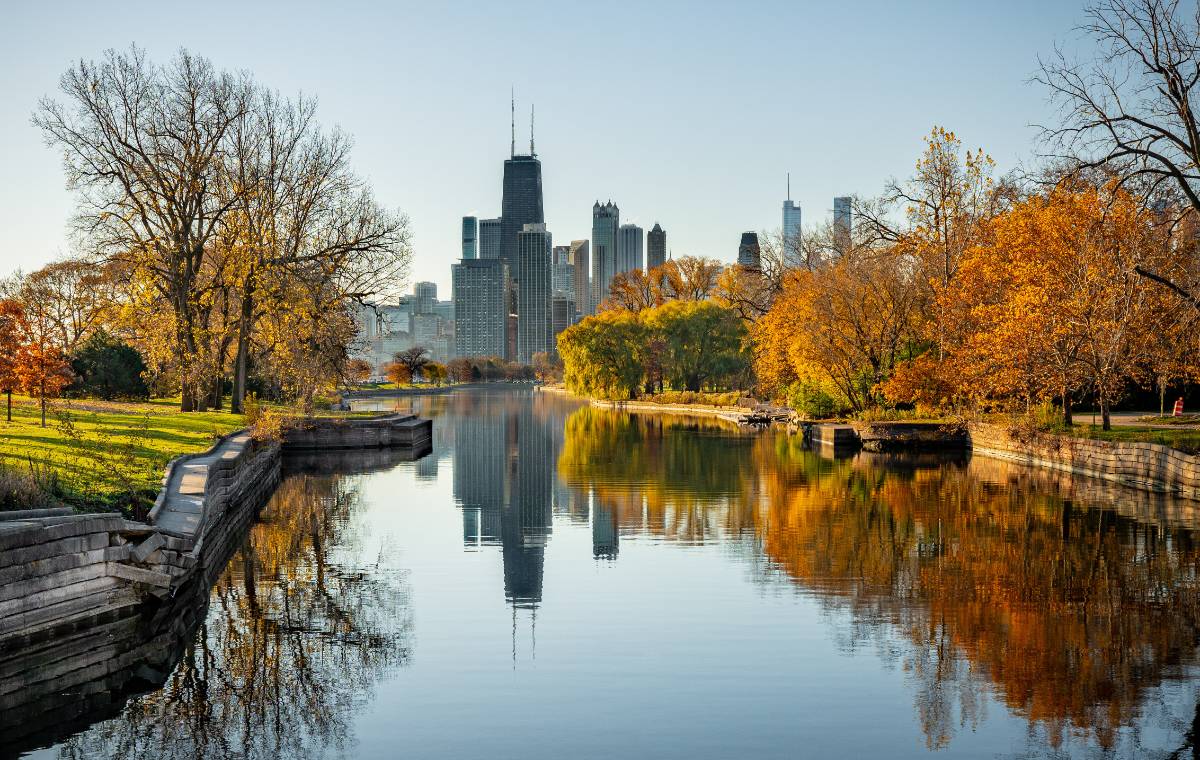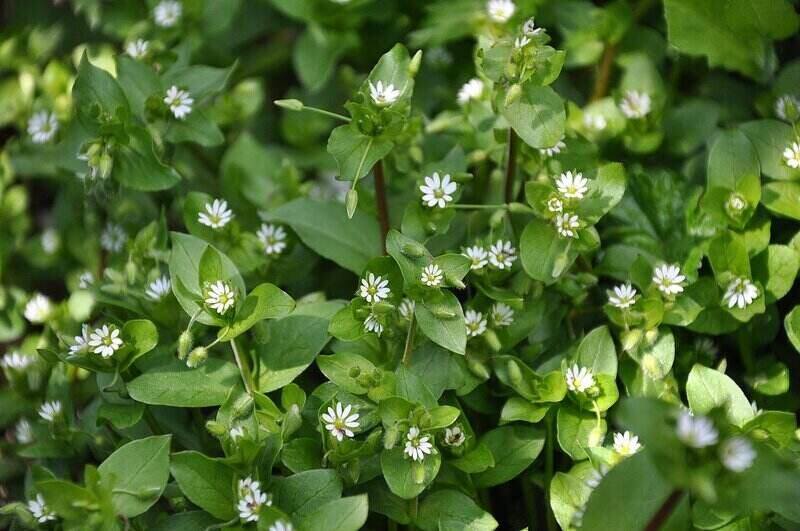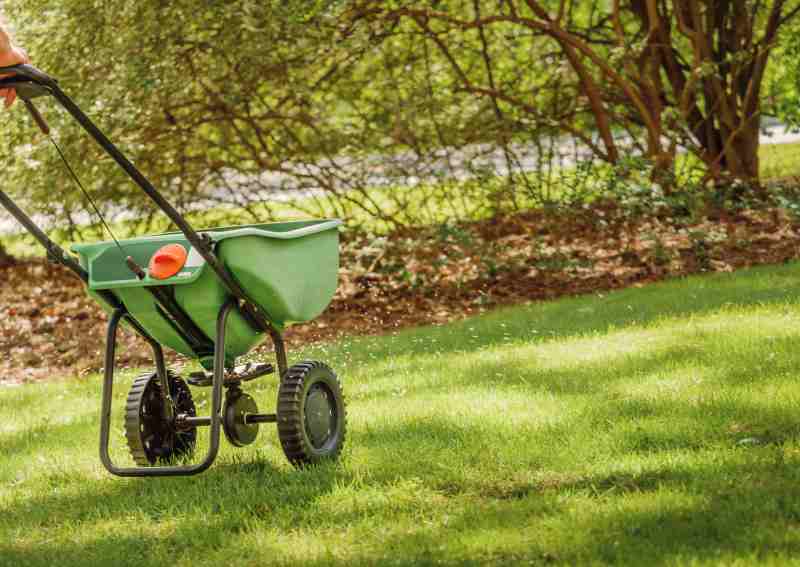
Fall lawn care in Chicago includes leaf removal (which can take a lot of time and effort on weekends), lawn fertilization, aeration, weed control, overseeding, and the last mow of the season.
That’s a lot of work, but soon mowing will be replaced by snow blowing across Chicagoland. The whole point of fall lawn care is to help your grass go into winter well-prepared.
Let’s get started…
1. Control Weeds

Late summer and fall are the best times in the Chicago area to apply a pre-emergent herbicide to tackle perennial broadleaf weeds like dandelions.
For winter annuals like chickweed that germinate in the fall, applying a pre-emergent application is ideal during this vulnerable moment in their lifecycle, the University of Illinois Extension notes.
See Related:
– How to Spray Your Lawn For Weeds
– How to Get Rid of Weeds in Grass
2. Apply Fertilizer
September and November are the best times to apply lawn fertilizer for cool-season grasses in Chicago. Fertilizing now prepares your grass for winter so your yard greens up earlier in spring. Use a fertilizer labeled for fall or winter application.
But when and how often do you need to fertilize your lawn?
U of I’s cool-season grasses fertilization schedule is based on lawn density.
- Low- to moderate-density lawns need fertilization 2 times: Early fall, spring and once in late summer.
- Moderate- to high-density lawns need fertilization 3 times: Once in late fall, once in spring, and once in late summer to early fall.
- High-density lawns need 4 fertilization treatments: Once each in late fall, spring, early summer (only with irrigated lawns); and late summer to early fall.
LawnStarter Pro Tip from Ricardo Flores in Waukegan: Asked what’s the secret to a perfect lawn, Flores replied: “Apply fertilizer 2 times a year.”
Yes, LawnStarter offers lawn fertilization in Chicago. This will save you choosing the right fertilizer for your grass and the time spent applying fertilizer.
See Related:
– When to Fertilize Kentucky Bluegrass
– When to Fertilize Fescue
3. Aerate in Fall

Fall is the best time to aerate because weeds are less common than in spring. Aeration is especially recommended where there’s a lot of foot traffic or where children play.
What is aeration? Aeration extracts about 3-inch plugs from the lawn. This allows water and other nutrients to reach the grass roots in Chicago’s lawns and reduces soil compaction.
Allow the plugs (they look a little bit like dog doo-doo) to remain. They will disintegrate in a couple of weeks and return nutrients to the soil.
See Related:
– What is Aeration [Video]
– Benefits of Aerating Your Lawn
4. Remove Those Leaves

To rake or not to rake? You can rake leaves off the lawn, mow them till they’re mulch, or hire a local leaf cleanup crew.
Whatever you do, don’t allow leaves to accumulate on your lawn because leaves will smother the grass and foster lawn diseases.
Here are your options:
- Raking: Raking takes a lot of time, and you’ll be bending over to pick up or bag those leaves. You can mulch those leaves instead – and those ground-up leaves will add nutrients to your lawn.
- Mulching: It may take a couple of swipes with the mower to crunch up the leaves, but that’s usually less time than raking and bagging.
- Hire a Leaf Removal Crew: Another way to get rid of those leaves? Hire one of LawnStarter’s Chicago leaf-removal pros who will rake or blow your leaves onto a tarp and bag them.
This last option saves you any strain on your back or knees from raking and bagging your leaves and from time lost mowing your lawn twice to mulch those leaves.
See Related:
– Is it Better to Rake or Mulch Leaves?
– Best Ways to Clean Up Leaves in Your Yard
5. Seed or Overseed Your Lawn

Just like fall is the best time to sow new grass in the Chicago area, it’s also the best time to thicken up your lawn.
In Illinois, the best time to overseed a lawn is late August to mid-September, according to Jonathan Green, a grass seed supplier. Here’s why: Soil temperatures at this time of year are still warm, which promotes optimum seed germination, and the cooler air temperatures are better for grass growth.
When overseeding, spread seed all over your lawn and water the seed.
When seeding a new lawn or filling in patchy areas, scratch up the bare spot and apply grass seed and water. Apply a light straw cover to deter birds from dining on the seeds.
See Related:
– How to Overseed Your Lawn in 8 Steps
– How to Plant Grass Seed
6. Last Mow of the Season

Continue mowing as needed, keeping the lawn at the height recommended for your grass type, until regular mowing wraps up in October.
University of Illinois Recommended Grass Heights
| Grass | Recommended Mowing Height |
| Kentucky bluegrass | 2-3 inches |
| Tall fescue | 2.5-3.5 inches |
| Creeping red fescue (a fine fescue) | 1.5-2 inches |
| Perennial ryegrass | 2-3 inches |
Some sources say to mow your lawn to 1.5 inches in fall, but the University of Illinois Extension recommends keeping at the same height all year. One reason why: Taller, thicker grass deters weed growth.
LawnStarter Pro Tip from David Solomon of Solomon’s Services in Chicago: The mistake I often notice homeowners make is mowing their lawn too short.
Once your lawn has stopped actively growing, you can stop mowing. Here in the Midwest, when we put away our lawn mowers for the season we pull out our snow shovels or snowblowers so we’re ready for winter.
See Related:
– When to Stop Mowing Your Lawn Before Winter
Lawn Care Is a Lot of Work. Hire a Pro
Fighting weeds, fertilizing, aerating, mowing your lawn — and especially raking and bagging or mulching leaves – that’s a lot of work and time lost in your yard on weekends. Let LawnStarter’s Chicago lawn care pros do your yard work.
LawnStarter’s local lawn care pros are mowing lawns and keeping grass green and healthy all across Chicagoland, from Waukegan to Elmhurst to Buffalo Grove to Arlington Heights. Professional lawn care help is just a few clicks or a quick call away.
Sources:
– Managing Weeds in Lawns, University of Illinois Extension
– Lawn Aeration, Chicago Botanic Garden
– When to Overseed Your Lawn in Illinois, Jonathan Green
– Mowing Your Lawn, University of Illinois Extension
Read Next:
– How to Winterize Your Chicago Garden
– Spring Lawn Care Checklist for Chicago
Main Image: Skyline of Chicago surrounded by fall foliage. Photo Credit: Anthony / Adobe Stock